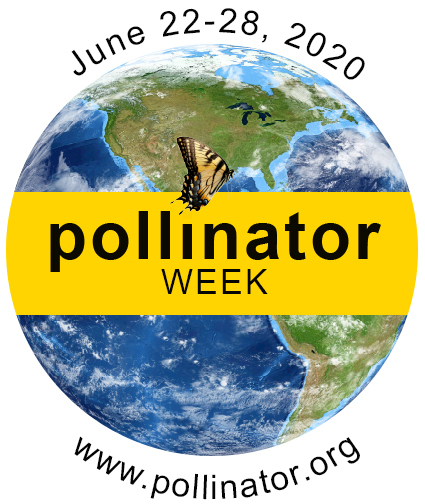
by Mary Salinas | Jun 23, 2020
For the 13th year we celebrate National Pollinator Week June 22-28 to bring awareness to the importance of our pollinators and the challenges they face. This is an opportunity to learn about ways to protect pollinators in our own landscapes. Every one of us can make a difference.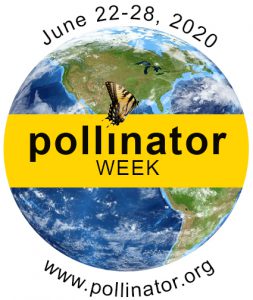
When we hear the word ‘pollinator’ most of us immediately think of honeybees. They are very important but there are so many other creatures that are important pollinators:
- Native bees – Florida alone has over 300 species of bees
- Hummingbirds – their long beaks can reach into long, tubular blooms
- Bats – they pollinate over 500 plants including banana, mango, and agave (used to make tequila)
- Beetles – considered to be a messy and minor pollinator; they pollinate the native paw paw
- Butterflies – a minor pollinator as most have long legs that keep them perched above the pollen
- Flies – pollinators of a variety of native plants
According to the USDA, 75% of flowering plants and about 35% of food crops around the globe rely on these animals for pollination. Without pollination, these plants would not reproduce or provide us food.
So, what can the average person do to make a difference?
- Plant what bees and butterflies love!
- Avoid using any insecticide unless it is absolutely necessary. Predators like assassin bugs, dragonflies and birds help to keep pests in check. Our songbirds rely on protein-rich insects (especially caterpillars) to feed their growing babies.
- Don’t treat areas where pollinators are visiting the flowers, whether in the lawn or the landscape beds.
- If you need to apply an insecticide to the lawn, mow first to remove the blooms from any weeds. Always follow the label instructions carefully.
- Avoid using a systemic insecticide on plants that bloom and attract pollinators. The insecticide can remain in plants for a long time.
Happy gardening during National Pollinator Week!
For more information:
Pollinator Partnership: Pollinator Week Activities
US Fish & Wildlife Pollinator Site
Native Insect Pollinators of the Southeastern United States brochure
Purdue University: Protecting Pollinators in Home Lawns and Landscapes
Minimizing Honey Bee Exposure to Pesticides
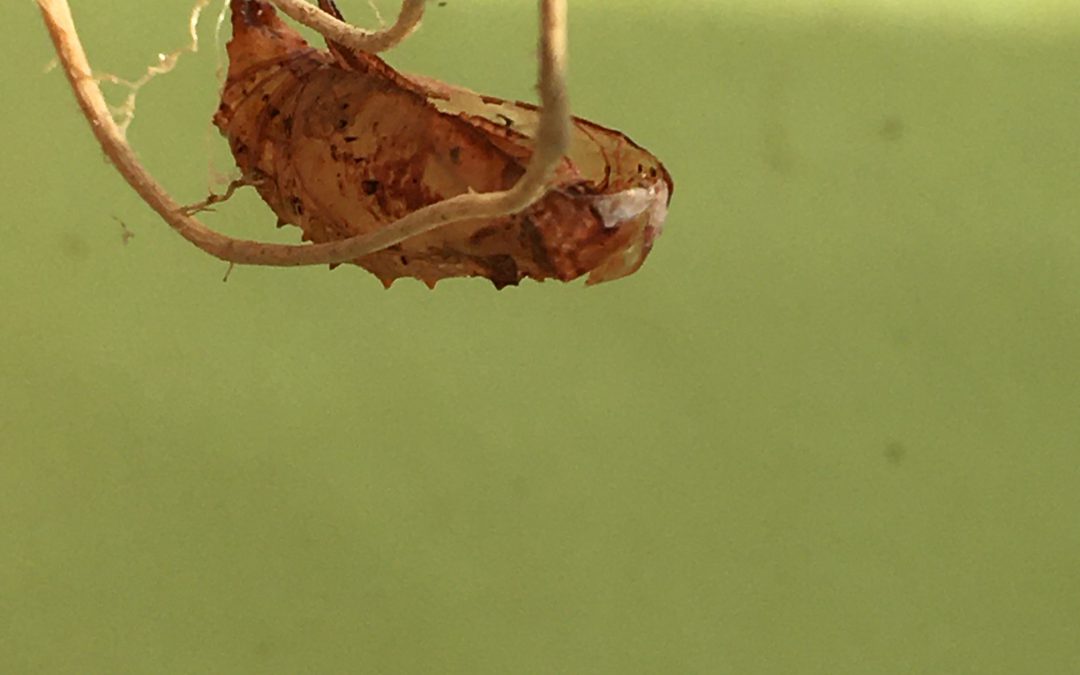
by Julie McConnell | May 13, 2020
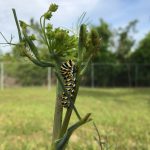
Eastern black swallowtail caterpillar on fennel. Photo: J_McConnell, UFIFAS
Working from home has given me the opportunity to take more notice of my landscape and allow more time for insect scouting. While looking for turfgrass pests a few weeks ago, I noticed a caterpillar I didn’t recognize feeding on a broadleaf weed in my lawn. Since it didn’t appear to be a typical turfgrass pest, I decided to collect a few and try to figure out what they were. I’m glad I did because it turned out they were Buckeye Butterfly larvae! This random find has led me to some experimentation with raising butterflies and I thought I’d share some tips in case others might like to try it.
**Before collecting be sure to consult the U.S. Fish and Wildlife list of endangered and threatened species in Florida and never collect from Florida State Parks or other dedicated conservation areas. Never release species not native to our ecosystem. **
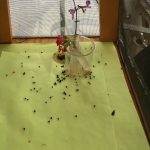
Lining the bottom of your enclosure with paper makes cleanup easier. Photo: J_McConnell, UFIFAS
You will need an adequate enclosure to keep caterpillars, chrysalises, and newly emerged butterflies/moths. I am fortunate to have a beautiful handmade cage constructed by a Master Gardener Volunteer at my disposal. It has a wooden frame and floor, screened walls, and the door latches. There are many options available for online purchase, but I would recommend getting one listed as “tall” or having a minimum height of 24 inches. Also, be sure you will be able to clean it easily – growing caterpillars create a lot of frass (excrement) that needs to be cleaned daily. I line the bottom of my enclosure with paper for quick cleanup.
Be sure you can offer fresh food for caterpillars and butterflies. Caterpillars usually have a limited menu of what they can eat depending on species. If you find them actively feeding on a plant, that is a pretty good sign that it is a good larval food source. Once you identify the caterpillar you can look up alternate larval host plants that the species eats.
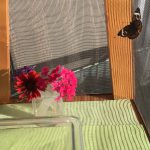
Provide a variety of fresh flowers when butterfly emerge
Collecting foliage and keeping it hydrated can be a challenge. I use small floral water tubes. They have rubber lids that pop on and off with slits where I can insert small stems, but the insects do not get in and drown. I usually set these in another container to keep them upright. I can easily add fresh flowers when I expect a butterfly to emerge so that nectar is available. If your enclosure is large enough you may be able to keep small potted plants inside, just remember to keep them watered.
Where do the caterpillars come from? I intentionally plant several plants that are larval butterfly (caterpillar) hosts such as parsley, fennel, and passionflower vine. I check these plants for caterpillars that I can collect along with foliage. After the butterflies emerge, I release them into my yard so they can find a mate and keep the cycle going.
For more information on attracting butterflies to your landscape see Butterfly Gardening in Florida.

by Larry Williams | Apr 23, 2020
One of the things to do while stuck at home due to COVID-19 restrictions, is to look for caterpillars and butterflies in your landscape. I’ve noticed giant swallowtail butterflies (Papilio cresphontes) a little early this year. The giant swallowtail is one of the largest and most beautiful butterflies in our area. Its larval stage is known as the orangedog caterpillar. This unusual name comes from the fact that it feeds on young foliage of citrus trees.
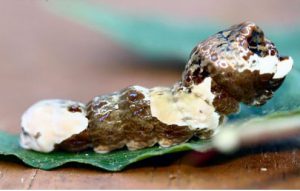
Orangedog caterpillar. Photo credit: Donald Hall, University of Florida
The orangedog caterpillar is mostly brown with some white blotches, resembling bird droppings more than a caterpillar. When disturbed, it may try to scare you off by extruding two orange horns that produce a pungent odor hard to wash off.
I’ve had some minor feeding on citrus trees in my landscape from orangedog caterpillars. But I tolerate them. I’m not growing the citrus to sell. Sure the caterpillars eat a few leaves but my citrus trees have thousands of leaves. New leaves eventually replace the eaten ones. I leave the caterpillars alone. They eat a few leaves, develop into chrysalises and then emerge as beautiful giant swallowtail butterflies. The whole experience is a great life lesson for my two teenagers. And, we get to enjoy beautiful giant swallowtail butterflies flying around in our landscape and still get plenty of fruit from the citrus trees. It is a win, win, win.
In some cases, the caterpillars can cause widespread defoliation of citrus. A few orangedog caterpillars can defoliate small, potted citrus trees. Where you cannot tolerate their feeding habits, remove them from the plant. But consider relocating the caterpillars to another area. In addition to citrus, the orangedog caterpillars will use the herb fennel (Foeniculum vulgare) and rue (Ruta graveolens) as a food source. Some butterfly gardens plant citrus trees to provide food for orangedog caterpillars so that they will have giant swallowtail butterflies. So you could plan ahead and grow some fennel, rue or find a butterfly garden in your area for the purpose of relocating the larvae.
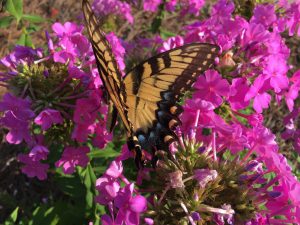
Yellow giant swallowtail butterfly on pink garden phlox flowers. Photo credit: Larry Williams
The adult butterflies feed on nectar from many flowers, including azalea, bougainvillea, Japanese honeysuckle, goldenrod, dame’s rocket, bouncing Bet and swamp milkweed. Some plants in this list might be invasive.
Keep in mind that mature citrus trees can easily withstand the loss of a few leaves. If you find and allow a few orangedog caterpillars to feed on a few leaves of a mature citrus tree in your landscape, you and your neighbors might get to enjoy the spectacular giant swallowtail butterfly.
More information on the giant swallowtail butterfly is available online at http://edis.ifas.ufl.edu/in134.
by Daniel J. Leonard | Jul 3, 2018
Each time I travel to central and south Florida and observe the wonderfully flamboyant tropical flora, I am reminded of the unique and frustrating climatic characteristics of Northwest Florida. Our weather is tropical enough through the summer to sustain virtually everything our friends to the south grow, but winters north of the Big Bend are just cold enough to prevent long-term success with most tropical species. However, the genus that is maybe most synonymous with tropical color, the Hibiscus (it even has its own texting emoji!), contains several species that are hardy through our winters. The best landscape plant of these hardy Hibiscus species is creatively (sarcasm) called Hardy Hibiscus or Giant Rose Mallow (Hibiscus moscheutos) and is an absolute star in the Panhandle, bringing the beauty of the tropics to your yard!
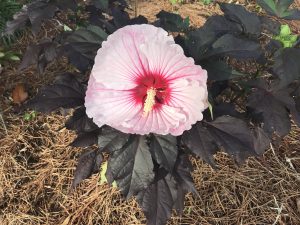
Hibiscus ‘Starry Starry Night’ – Photo courtesy Daniel Leonard
Rose Mallow is a native perennial species that occurs in sunny wetlands across the eastern U.S. This species can grow 7-8’ in height in its natural, unimproved state and possesses the largest flowers of any hardy perennial, some varieties easily eclipse 12” in diameter. Rose Mallows bloom through the heat of our long summers and return reliably each winter unfazed by frost. The flowers also happen to be a favorite of butterflies and hummingbirds and bring beneficial wildlife to the landscape. These characteristics and the trend towards the use of pollinator friendly, low-maintenance native perennials in landscapes quickly made Rose Mallow a jewel for plant breeders and now virtually all major horticultural brands have a line of Hardy Hibiscus available at garden centers, in varying sizes, flower color and leaf color/form. Recent breeding efforts have focused on introducing plants with enormous, richly colored flowers held on compact plants with attractive foliage. The results have yielded two series and three individual cultivars that I consider superior selections and are more than worthy of inclusion in your garden:
- Summerific® Series by Proven Winners. This series is comprised of four robust (up to 5’ in height) cultivars, ‘Cherry Cheesecake’ (bicolor magenta and white flowers), ‘Berry Awesome’ (purplish lavender flowers), ‘Cranberry Crush’ (a red you really have to see to believe), and ‘Perfect Storm’ (notable for its deep purple foliage).
- Luna Series by Monrovia. This series is notable for its ultra-compact (3’ in height or less) size and characteristically large flowers. It is also composed of four cultivars, ‘Luna Red’ (deep red), ‘Luna Blush’ (white, fading to pink near flower margins), ‘Luna Pink Swirl’ (pictured and my favorite, bicolor swirly flowers), and ‘Luna White’ (white with a red center).
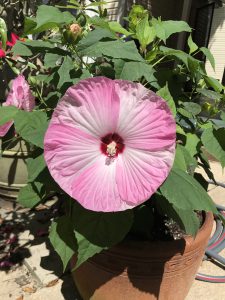
Hibiscus ‘Luna Pink Swirl’ – Photo courtesy Daniel Leonard
- ‘Starry Starry Night’ by Walter’s Gardens. (Pictured) This cultivar combines dark purple to black leaves with swirled pale and dark pink flowers. It has performed very well in my landscape and if I could only grow one, this might be it.
- ‘Lord Baltimore.’ The classic, large growing cultivar with bright red flowers that is widely available and easily found. An oldie (introduced in 1955) but a goodie.
- ‘Midnight Marvel’ by Walter’s Gardens. A “hot off the press” new cultivar that is currently difficult to find due to popularity, though some online outlets have them available in small sizes. This one is worth your patience. Sporting deep red blooms on near black foliage, there’s nothing else like it in the landscape.
In addition to being gorgeous plants, Rose Mallows are extremely versatile in the landscape and could not be easier to grow. Because the size varies so greatly (from the diminutive 30” tall ‘Luna’ series to the 8’ tall unimproved species), there really is a place for one in every garden. I like to use the smaller cultivars in large containers to facilitate moving them around where their floral display has the greatest impact or to create a tropical effect where in ground plantings are not an option (pool decks, patios, etc). The larger cultivars make spectacular specimen plantings in perennial and shrub beds and even make a really dense, striking hedge (just know they disappear in the winter). Be sure to give them as much sun as possible, as this will enhance the number of flowers on each plant and darken the foliage on the cultivars with purplish/black leaves. Too little sun will result in fewer flowers and lighter green foliage. As wetland plants, Rose Mallows enjoy regular water, either from rainfall or irrigation; they will let you know when they need it – their large leaves readily wilt under drought stress, somewhat like Hydrangea.
For low-maintenance, native, pollinator friendly, cold-hardy tropical color, you need look no further than Rose Mallow. These perennial shrubs come in all sizes and colors and fit any landscape! Look for the above listed series and cultivars at better garden centers and online retailers and enjoy the oohs and ahhs elicited when people first get a glimpse of Hardy Hibiscus in your landscape! Happy Gardening!
by Daniel J. Leonard | Jun 21, 2018
It’s that time of year. School is out, hurricane season is in, and the mercury is up! Gardens wilt by midday and gardeners retreat into the air conditioning long before then. Unless you have your toes in the water on one of Northwest Florida’s beautiful beaches, it can be a miserable time to be a Floridian, for plants and people! However, despite the relentless heat and blistering sunshine, low-maintenance, eye-catching color can still be had in the landscape. When the calendar flips to June, I turn to my two favorite Florida-Friendly annuals to do the heavy lifting in my landscape: ‘Diamond Frost’ Euphorbia, and the ‘Cora’ Vinca series.
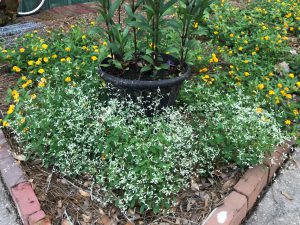
‘Diamond Frost’ Euphorbia – Photo Courtesy Daniel Leonard
A relative newcomer to landscapes, the award winning ‘Diamond Frost’ Euphorbia is an amazing introduction from Proven Winners. The ultimate in tough, ‘Diamond Frost’ does great both as a mounding accent in a container or as a standalone bedding plant in the landscape. Though its individual, teardrop-shaped, white flowers are tiny, the hundreds of them that open each day really pack a floral punch in the landscape! One caveat: if planting in the landscape, I find ‘Diamond Frost’ to be most effective massed in groups of three or more. Due to the daintiness of the flowers, a single plant can get lost among other garden inhabitants. However, when done right, ‘Diamond Frost’ is a proven winner in any landscape!
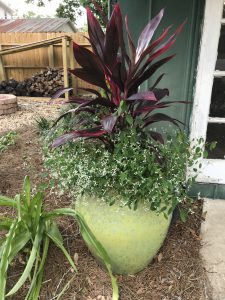
Mixed container featuring ‘Diamond Frost’ Euphorbia – Photo Courtesy Daniel Leonard
Next, the ‘Cora’ series of Vinca (Catharanthus roseus), also introduced by Proven Winners, is an improvement on an old favorite. Note: This species is also, on occasion, called Periwinkle. However, do not confuse it with the spreading, purple-flowered, perennial groundcover of the same common name! Gardeners in the South have been growing Vincas for years. This species is unbelievably tolerant of harsh conditions, sometimes even seen growing in sidewalk cracks! However, the unimproved species had an Achilles heel: susceptibility to Phytophthora, a devastating fungal rot disease. ‘Cora’ overcomes this issue and is as close to a perfect bedding annual as you’re likely to find. The ‘Cora’ series is composed of cultivars with pinwheel-shaped white, pink and lavender flowers, a color for everyone! The kind (and clever) marketing folks at Proven Winners have even made ‘Cora’ easy to spot on retail nursery benches; just look for the plants in the hot pink containers!
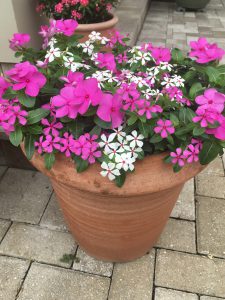
‘Cora’ Vinca
Photo: Andrea Schnapp
Both of the above-described plants are extremely undemanding of gardeners. Once established, little is required in the way of irrigation and fertilization. To ensure success, water daily for the first week after planting, back off to a couple of times per week for the next two weeks or so and then watch ‘Diamond Frost’ and ‘Cora’ thrive with only rainfall for the rest of the summer! Keep in mind, during periods of excessive drought, supplemental watering may be required to keep any plant, even drought tolerant ones, looking their best! To meet the minimal nutrition demands of these plants, I incorporate a quality, slow-release fertilizer (for example, Osmocote, Harrell’s Polyon, or any other similar product) at planting. These products last two or three months in our rainy, hot, humid climate and generally need a second application accordingly for full-season performance. ‘Diamond Frost’ Euphorbia and ‘Cora’ Vinca also require full, blazing sun for maximum floral performance. Don’t be shy about siting them in harsh, sunny places, even a few hours of shade tend to make leggier plants that flower less!
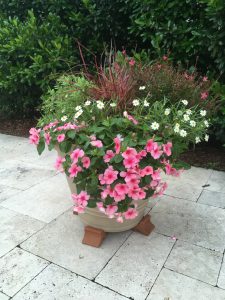
Mixed container with ‘Cora’ Vinca accent
Photo: Andrea Schnapp
When you need low-maintenance, season long color that can beat the heat, look for ‘Diamond Frost’ Euphorbia and the ‘Cora’ series of Vinca at your local nursery! Stay cool out there folks and happy gardening!















